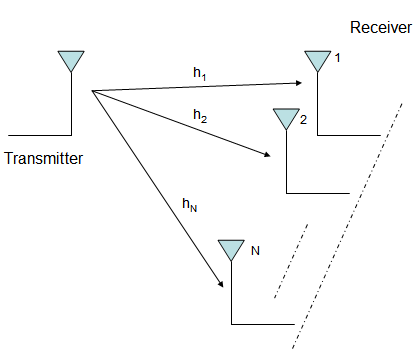Antenna diversity, also known as space diversity, is any one of several wireless diversity schemes that use two or more antennas to improve the quality and reliability of a wireless link.
Receiver diversity is a form of space diversity, where there are multiple antennas at the receiver. The presence of receiver diversity poses an interesting problem – how do we use ‘effectively‘ the information from all the antennas to demodulate the data. There are multiple ways to approach the problem. The three typical approaches to be discussed are – selection diversity, equal gain combining and maximal ratio combining. In this post we will discuss selection diversity. For the discussion, we will assume that the channel is a flat fading Rayleigh multipath channel and the modulation is BPSK.

Receiver diversity is a form of space diversity, where there are multiple antennas at the receiver. The presence of receiver diversity poses an interesting problem – how do we use ‘effectively‘ the information from all the antennas to demodulate the data. There are multiple ways to approach the problem. The three typical approaches to be discussed are – selection diversity, equal gain combining and maximal ratio combining. In this post we will discuss selection diversity. For the discussion, we will assume that the channel is a flat fading Rayleigh multipath channel and the modulation is BPSK.
Background
1. We have N receive antennas and one transmit antenna.
2. The channel is flat fading – In simple terms, it means that the multipath channel has only one tap.
3. The channel experienced by each receive antenna is randomly varying in time. For the ith receive antenna, each transmitted symbol gets multiplied by a randomly varying complex number hi. As the channel under consideration is a Rayleigh channel, the real and imaginary parts of hi are Gaussian distributed having mean 0 and variance 1/2.
3. The channel experienced by each receive antenna is randomly varying in time. For the ith receive antenna, each transmitted symbol gets multiplied by a randomly varying complex number hi. As the channel under consideration is a Rayleigh channel, the real and imaginary parts of hi are Gaussian distributed having mean 0 and variance 1/2.
4. The channel experience by each receive antenna is independent from the channel experienced by other receive antennas.
5. The noise on each receive antenna is independent from the noise on the other receive antennas.
6. At each receive antenna, the channel hi is known at the receiver. For example, on the ith receive antenna, equalization is performed at the receiver by dividing the received symbol yi by the apriori known hi
What is selection diversity?
What is selection diversity?
Consider a scenario where we have a single antenna for transmission and multiple antennas at the receiver (as shown in the figure below).
 |
| Figure: Receive diversity in a wireless link |
At the receiver we have now N copies of the same transmitted symbol. Which then poses the problem – how to effectively combine them to reliably recover the data.
Selection diversity approach is one way out – With selection diversity, the receiver selects the antenna with the highest received signal power and ignore observations from the other antennas. The chosen receive antenna is one which gives max(signal power).
Effective bit energy to noise ratio in a N receive antenna case is N times the bit energy to noise ratio for single antenna case.BER Simulation Algorithm
The Matlab/Octave script performs the following
(a) Generate random binary sequence of +1’s and -1’s.
(b) Multiply the symbols with the channel and then add white Gaussian noise.
(c) At the receiver, find the receive path with maximum power
(d) Chose that receive path, equalize (divide) the received symbols with the known channel
(d) Perform hard decision decoding and count the bit errors
(e) Repeat for multiple values of Eb/No and plot the simulation and theoretical results.

No comments:
Post a Comment